Universal Pictures (also known as Universal Studios or Universal) is one of Hollywood's ‘Big Six’ films studios, and now owned by Comcast. Founded in 1912, it is the world's fifth oldest after Gaumont, Pathé, Titanus, and Nordisk Film, and the oldest surviving film studio in the United States. During Hollywood's golden age, Universal was one of the ‘Little Three’ majors. In two posts we tell the story of Universal and its stars. Today, part 1: 1912–1936. Under Movie Mogul Carl Laemmle, Universal was one of the leading producers of film serials in the 1920s and of popular horror films in the 1930s. Universal also presented many of the silent films of Erich von Stroheim and the classic anti-war film All Quiet on the Western Front (1930).
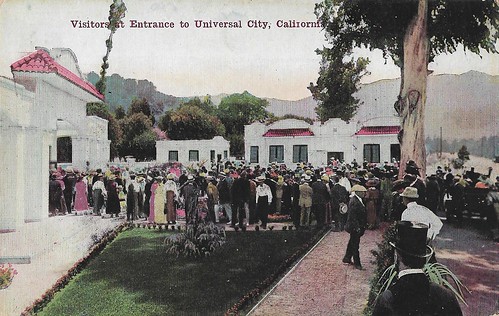
Visitors at Entrance to Universal City. American postcard by Van Ornum Colorprint Co, Los Angeles, no. 778. This postcard may refer to the opening of the Second Universal City on Lankershim Bd. on 15 March 1915.
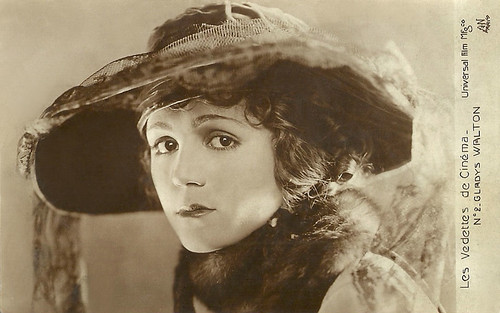
Gladys Walton. French postcard in the Les Vedettes de Cinéma series by A.N., Paris, no. 2. Photo: Universal Film.
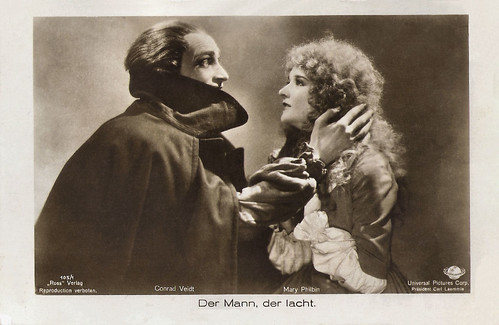
German postcard by Ross Verlag, no. 105/1. Photo: Universal Pictures Corp. Publicity still for The Man Who Laughs (Paul Leni, 1928) with Mary Philbin and Conrad Veidt.
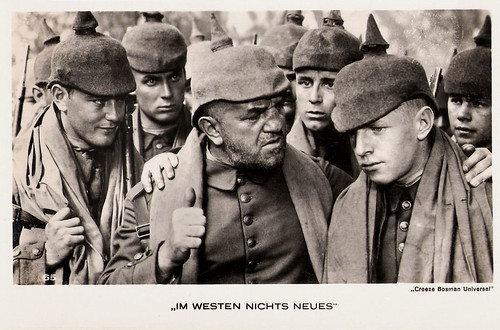
Dutch postcard by Croeze-Bosman-Universal, no. 65. Postcard for the American WWI, anti-war-film All Quiet on the Western Front (1930), based on the novel Im Westen nichts neues by Erich Maria Remarque, and starring Lew Ayres, Louis Wolheim and Owen Davis jr.

American postcard by Classico San Francisco, no. 233/007. Photo: Roman Freulich / Universal Pictures. Publicity still for The Bride of Frankenstein (James Whale, 1935) with Elsa Lanchester and Boris Karloff.
Universal Studios was founded in 1912 by Carl Laemmle, Mark Dintenfass, Charles O. Baumann, Adam Kessel, Pat Powers, William Swanson, David Horsley, Robert H. Cochrane and Jules Brulatour.
After immigrating to America in 1884, Carl Laemmle spent the next decade at a series of dead-end jobs, mostly in Chicago, then worked for another 12 years at a dry-goods store in Oshkosh, Wisconsin. In 1905, while he searched for a place to open a clothing store in Chicago, Laemmle stumbled onto a line of people waiting to see a nickelodeon. Intrigued by the popularity of moving pictures, Laemmle changed careers and opened a nickelodeon, The White Front Theater. Soon, Laemmle was the owner of several nickelodeons and had also established a film distribution business.
The creation in 1908 of the Motion Picture Trust by Thomas Edison and others meant that exhibitors were expected to pay fees for Trust-produced films they showed. Based on several patents, the trust collected fees on all aspects of film production and exhibition, and attempted to enforce a monopoly on distribution. Although he was an original member of Edison’s Motion Picture Patents Company, Laemmle bristled at the idea of paying royalties to move to the next level: film production.
In June 1909, Laemmle started the Yankee Film Company with partners Abe Stern and Julius Stern. That company quickly evolved into the Independent Moving Pictures Company (IMP), with studios in Fort Lee, New Jersey. The first effort of the studio involved a one-reel film entitled Hiawatha (William V. Ranous, 1909), a 15-minute version of Henry Wadsworth Longfellow's famous poem. Eventually, production would increase to an average of one film per week.
In the meantime, Edison's agents did their best to shut IMP down. Laemmle broke with the trust’s custom of refusing to give billing and screen credits to performers. By naming the film stars, he attracted many of the leading players of the time, and contributed to the creation of the star system. In 1910, he promoted Florence Lawrence, formerly known as ‘The Biograph Girl’, and actor King Baggot, and IMP became one of the first studios using stars in its marketing.
The Universal Film Manufacturing Company was incorporated in New York in 1912 when IMP merged with five other companies. Carl Laemmle, who became president, was the primary figure in the partnership. Eventually all would be bought out by Laemmle. The new Universal studio was a vertically integrated company, with film production, distribution and exhibition venues all linked in the same corporate entity, the central element of the Studio system era. Following the westward trend of the industry, by the end of 1912 the company was focusing its production efforts in the Hollywood area. Hollywoodland, as it was known at the time, was a perfect place for the independent film makers to regroup and build their respective businesses.
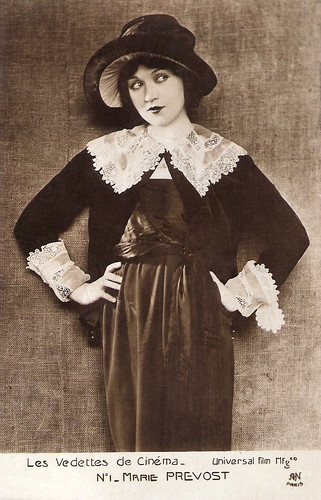
Marie Prevost. French postcard by A.N., Paris in the Les Vedettes de Cinéma, series, no. 1. Photo: Universal Film.
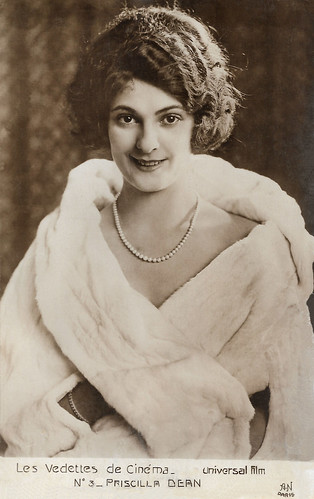
Priscilla Dean. French postcard by A.N., Paris in the Les Vedettes de Cinéma, series, no. 3. Photo: Universal Film.

Baby Peggy. French postcard in the Les Vedettes de Cinéma series by A.N., Paris, no. 4. Photo: Universal Film.
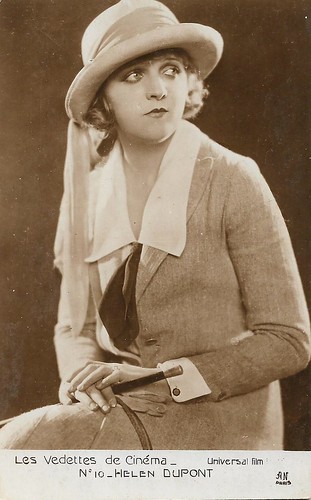
Helen Dupont. French postcard in the Les Vedettes de Cinéma series by A.N., Paris, no. 10. Photo: Universal Film.
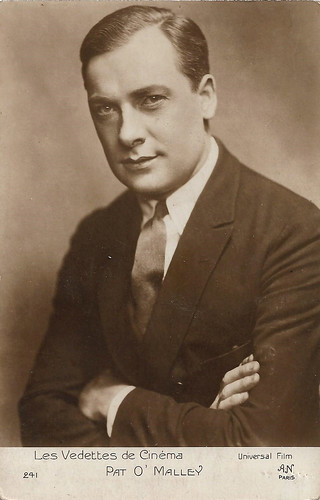
Pat O'Malley. French postcard in the Les Vedettes de Cinéma series by A.N., Paris, no. 241. Photo: Universal Film.
Universal offered a variety of film packages which allowed an exhibitor to show a different film every day. The Complete Service Plan, for example, included a two-reel comedy, a serial, and a feature film. One of the first hits of Universal was the adventure-drama Ivanhoe (Herbert Brenon, 1913) starring King Baggot, and based on the epic historical novel by Sir Walter Scott. Produced by Carl Laemmle's Independent Moving Pictures after IMP was absorbed into the newly founded Universal, which was the distributor, the screenplay was adapted by Brenon. Ivanhoe was filmed on location in the United Kingdom. It was one of the first expeditions of an American studio abroad.
Another success was the silent crime drama Traffic in Souls/While New York Sleeps (George Loane Tucker, 1913), focusing on forced prostitution (white slavery) in the United States. Traffic in Souls consists of six reels which was longer than most American film of the era. The film grossed $0.5 million and its significance was also in the innovative editing and plot lines which gave the impression of simultaneously occurring events.
Lucille Love, Girl of Mystery (Francis Ford, 1914) with Grace Cunard was Universal’s first serial. Then followed the fantasy Neptune's Daughter (Herbert Brenon, 1914 ) with former swimming champion Annette Kellerman. It was based on Kellerman's idea of "a water fantasy movie with beautiful mermaids in King Neptune's garden together with a good love story." It was filmed by Universal on Bermuda, cost approximately $50,000, and grossed one million dollars at the box office.
Land in California was cheap and weather-wise, ideal. In 1915, Laemmle opened the world's largest motion picture production facility, Universal City Studios, on a 230-acre (0.9-km²) converted farm just over the Cahuenga Pass from Hollywood. Studio management became the third facet of Universal's operations, with the studio incorporated as a distinct subsidiary organisation. Unlike other movie moguls, Laemmle opened his studio to tourists. About 500 people visited Universal City daily until the advent of sound films required enclosed stages.
Universal became the largest studio in Hollywood, and remained so for a decade. However, it sought an audience mostly in small towns, producing mostly inexpensive melodramas, Westerns and serials. In its early years Universal released three brands of feature films—Red Feather, low-budget programmers; Bluebird, more ambitious productions; and Jewel, their prestige motion pictures. It held a talented roster of stars such as Lon Chaney, Mae Murray, Harry Carey and Rudolph Valentino. Directors included Jack Conway, John Ford, Rex Ingram, Robert Z. Leonard, George Marshall and Lois Weber, one of the few women directing films in Hollywood. Among her successes were the dramas Where Are My Children? (Phillips Smalley and Lois Weber, 1916), starring Tyrone Power, Sr. and Marie Walcamp, and Shoes (Lois Weber, 1916) starring Mary MacLaren. John Ford directed several silent Westerns with Harry Carey such as A Marked Man (John Ford, 1917) and The Phantom Riders (John Ford, 1918).
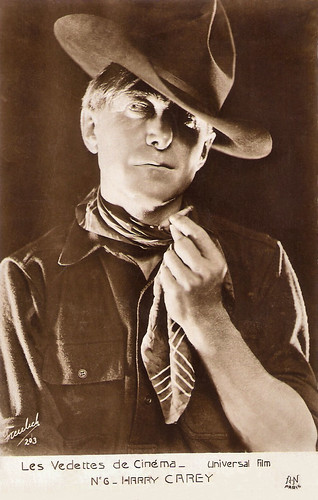
Harry Carey. French postcard by A.N., Paris, in the series Les Vedettes de Cinéma, no. 6. Photo: Universal Film / Roman Freulich, no. 203.
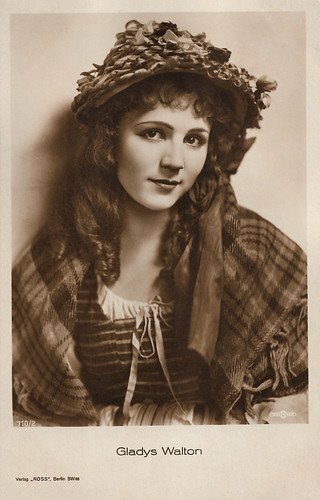
Gladys Walton. German postcard by Ross Verlag, Berlin, no. 710/2, 1925-1926. Photo: Unifilman (Universal).
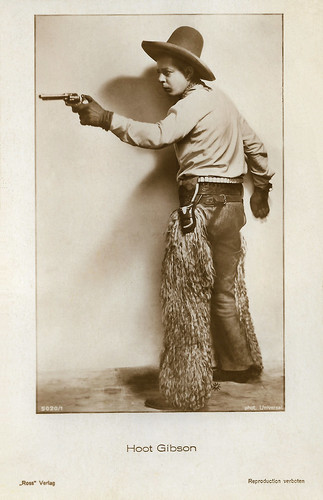
Hoot Gibson. German postcard by Ross Verlag, no. 5020/1, 1930-1931. Photo: Universal. Publicity still for The Galloping Kid (Nat Ross, 1922).
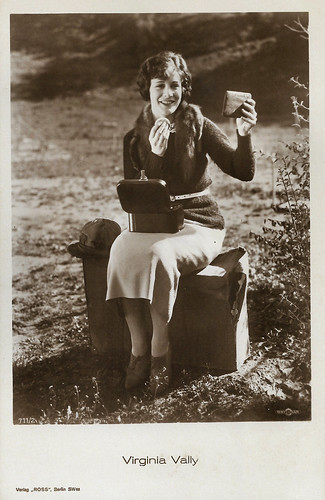
Virginia Valli. German postcard by Ross Verlag, no. 711/2, 1925-1926. Photo: Unifilman.
Despite Laemmle's role as an innovator, he was an extremely cautious studio chief. Unlike rivals Adolph Zukor, William Fox, and Marcus Loew, Laemmle chose not to develop a theatre chain. He also financed all of his own films, refusing to take on debt. This policy nearly bankrupted the studio when actor-director Erich von Stroheim insisted on excessively lavish production values for his films Blind Husbands (1919) and Foolish Wives (1922), but Universal shrewdly gained a return on some of the expenditure by launching a sensational ad campaign that attracted filmgoers.
Character actor Lon Chaney became a drawing card for Universal in the 1920s, first appearing steadily in dramas such as The Trap (Robert Thornby, 1922). His two biggest hits for Universal were The Hunchback of Notre Dame (Wallace Worsley, 1923) and The Phantom of the Opera (Rupert Julian, 1925) with Mary Philbin and Norman Kerry.
During this period Laemmle entrusted most of the production policy decisions to Irving Thalberg. Thalberg had been Laemmle's personal secretary, and Laemmle was impressed by his smart observations of how efficiently the studio could be operated. Promoted to studio chief, 'the Boy Wonder' was giving Universal's product a touch of class, but MGM's head of production Louis B. Mayer lured Thalberg away from Universal with a promise of better pay. Without his guidance Universal became a second-tier studio, and would remain so for several decades.
In 1928, Laemmle, Sr. made his son, Carl Laemmle, Jr. head of Universal Pictures as a 21st birthday present. Universal already had a reputation for nepotism—at one time, 70 of Carl, Sr.'s relatives were supposedly on the payroll. Among these relatives was future Academy Award-winning director/producer William Wyler. ‘Junior’ Laemmle persuaded his father to bring Universal up to date. He bought and built theatres, converted the studio to sound production, and cut the studio's output by 40 percent in order to allow for longer films of higher quality.
His interest in novels led to several prominent productions. Universal put over $1,000,000 into The Man Who Laughs (1928), an extremely high budget for an American film of the time. The Man Who Laughs (1928) is a romantic drama directed by the German Expressionist filmmaker Paul Leni. It stars Mary Philbin as the blind Dea and Conrad Veidt as Gwynplaine. The film is known for the grim carnival freak-like grin on Gwynplaine's face.

Lon Chaney. French postcard by A.N., Paris, no. 52. Photo: Universal Film. Collection: Didier Hanson.
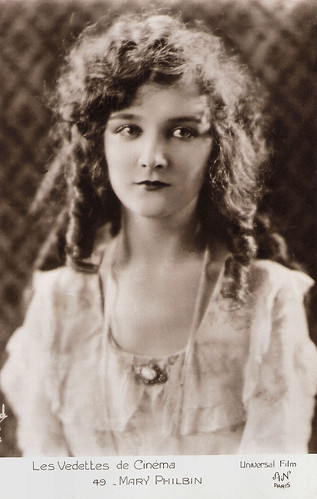
Mary Philbin. French postcard in the Les Vedettes de Cinéma series by A.N., Paris, no. 49. Photo: Universal Film.

Norman Kerry. French postcard in the Les Vedettes de Cinéma series by A.N., Paris, no. 239. Photo: Universal Film.

Conrad Veidt. Dutch postcard, no. 142. Photo: Universal.

Reginald Denny. Austrian postcard by Iris-Verlag, Paris, no. 5324. Photo: Universal-Film.
Carl Jr. ‘s early efforts included the critically panned part-talkie version of Edna Ferber's novel Show Boat (Harry A. Pollard, 1929), the lavish musical Broadway (Paul Fejos, 1929) which included Technicolor sequences; and the all-color musical King of Jazz (John Murray Anderson, 1930). The anti-war film All Quiet on the Western Front (Lewis Milestone, 1930), won its year's Best Picture Oscar, the studio's first.
Laemmle, Jr. created a niche for the studio, beginning a series of horror films which extended into the 1940s, affectionately dubbed Universal Horror. Among them are Dracula (Tod Browning, 1931) with Béla Lugosi, Frankenstein (James Whale, 1931) with Boris Karloff, The Mummy (Karl Freund, 1932), The Invisible Man (James Whale, 1933) with Claude Rains, and The Bride of Frankenstein (James Whale, 1935). Other Laemmle productions of this period include the melodramas Imitation of Life (John M. Stahl, 1934) starring Claudette Colbert, and the screwball comedy My Man Godfrey (Gregory La Cava, 1936) with Carole Lombard.
Most of the higher quality films that Laemmle, Jr., initiated did not engage the audiences of their day, however, and box office receipts did not compensate for the high cost of feature film production. Taking on the task of modernising and upgrading a film conglomerate in the depths of the depression was risky, and for a time Universal slipped into receivership. The theatre chain was scrapped, but Carl, Jr. held fast to distribution, studio and production operations.
The end for the Laemmles came with a lavish version of Show Boat (James Whale, 1936), a remake of its earlier 1929 part-talkie production, and produced as a high-quality, big-budget film rather than as a B-picture. The new film featured several stars from the Broadway stage version, which began production in late 1935, and unlike the 1929 film was based on the Broadway musical rather than the novel.
Carl, Jr.'s spending habits alarmed company stockholders. After a costly flop with Sutter's Gold (James Cruze, 1936), the stockholders would not allow production to start on Show Boat unless the Laemmles obtained a loan. Universal was forced to seek a $750,000 production loan from the Standard Capital Corporation, pledging the Laemmle family's controlling interest in Universal as collateral. It was the first time Universal had borrowed money for a production in its 26-year history. The production went $300,000 over budget; Standard called in the loan, cash-strapped Universal could not pay, Standard foreclosed and seized control of the studio in 1936. Although Show Boat (released a little over a month later) became a critical and financial success, it was not enough to save the Laemmles' involvement with the studio. They were unceremoniously removed from the company they had founded. Carl Laemmle Sr. died in 1939 in Los Angles at the age of 72.
From 1912 till 1936, Universal Pictures had various logos. The first logo that was used already showed a globe which has a lot of resemblance to Saturn with its ring. In 1923 a new logo shows a plane flying around the world leaving a trail of smoke which slowly turn into the words 'Universal Pictures'. In 1927 an updated version of the previous logo was introduced which also has the plane flying around the globe. The text now read 'A Universal Picture'. It would stay until 1936. To be continued.

Ivan Mozzhukhin. German postcard by Ross Verlag, no. 3179/4, 1928-1929. Photo: Freulich / Universal / Matador. Publicity still for Surrender (Edward Sloman, 1927).
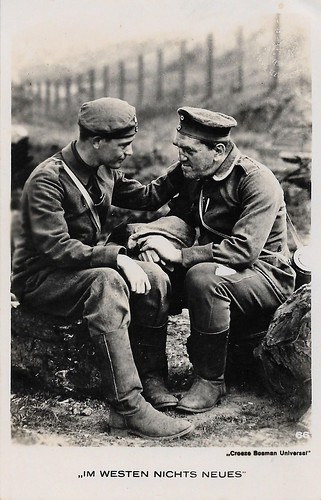
Dutch postcard by Croeze-Bosman-Universal. Postcard for the American WWI, anti-war-film All Quiet on the Western Front (1930), based on the novel Im Westen nichts neues by Erich Maria Remarque, and starring Lew Ayres and Louis Wolheim.

Béla Lugosi. British postcard in the Picturegoer series. Photo: Universal. Collection: Didier Hanson.

Boris Karloff. British postcard in the Picturegoer series, London, no 707 H. Photo: Universal.

British postcard in the Filmshots series by Film Weekly. Photo: Universal. Publicity still for The Invisible Man (James Whale, 1933) with Gloria Stuart.
Sources: David S. Smith (IMDb), Encyclopaedia Britannica, My Film Views, Universal Pictures.com, Funding Universe, Wikipedia and IMDb.

Visitors at Entrance to Universal City. American postcard by Van Ornum Colorprint Co, Los Angeles, no. 778. This postcard may refer to the opening of the Second Universal City on Lankershim Bd. on 15 March 1915.

Gladys Walton. French postcard in the Les Vedettes de Cinéma series by A.N., Paris, no. 2. Photo: Universal Film.

German postcard by Ross Verlag, no. 105/1. Photo: Universal Pictures Corp. Publicity still for The Man Who Laughs (Paul Leni, 1928) with Mary Philbin and Conrad Veidt.

Dutch postcard by Croeze-Bosman-Universal, no. 65. Postcard for the American WWI, anti-war-film All Quiet on the Western Front (1930), based on the novel Im Westen nichts neues by Erich Maria Remarque, and starring Lew Ayres, Louis Wolheim and Owen Davis jr.

American postcard by Classico San Francisco, no. 233/007. Photo: Roman Freulich / Universal Pictures. Publicity still for The Bride of Frankenstein (James Whale, 1935) with Elsa Lanchester and Boris Karloff.
Independents against the trust
Universal Studios was founded in 1912 by Carl Laemmle, Mark Dintenfass, Charles O. Baumann, Adam Kessel, Pat Powers, William Swanson, David Horsley, Robert H. Cochrane and Jules Brulatour.
After immigrating to America in 1884, Carl Laemmle spent the next decade at a series of dead-end jobs, mostly in Chicago, then worked for another 12 years at a dry-goods store in Oshkosh, Wisconsin. In 1905, while he searched for a place to open a clothing store in Chicago, Laemmle stumbled onto a line of people waiting to see a nickelodeon. Intrigued by the popularity of moving pictures, Laemmle changed careers and opened a nickelodeon, The White Front Theater. Soon, Laemmle was the owner of several nickelodeons and had also established a film distribution business.
The creation in 1908 of the Motion Picture Trust by Thomas Edison and others meant that exhibitors were expected to pay fees for Trust-produced films they showed. Based on several patents, the trust collected fees on all aspects of film production and exhibition, and attempted to enforce a monopoly on distribution. Although he was an original member of Edison’s Motion Picture Patents Company, Laemmle bristled at the idea of paying royalties to move to the next level: film production.
In June 1909, Laemmle started the Yankee Film Company with partners Abe Stern and Julius Stern. That company quickly evolved into the Independent Moving Pictures Company (IMP), with studios in Fort Lee, New Jersey. The first effort of the studio involved a one-reel film entitled Hiawatha (William V. Ranous, 1909), a 15-minute version of Henry Wadsworth Longfellow's famous poem. Eventually, production would increase to an average of one film per week.
In the meantime, Edison's agents did their best to shut IMP down. Laemmle broke with the trust’s custom of refusing to give billing and screen credits to performers. By naming the film stars, he attracted many of the leading players of the time, and contributed to the creation of the star system. In 1910, he promoted Florence Lawrence, formerly known as ‘The Biograph Girl’, and actor King Baggot, and IMP became one of the first studios using stars in its marketing.
The Universal Film Manufacturing Company was incorporated in New York in 1912 when IMP merged with five other companies. Carl Laemmle, who became president, was the primary figure in the partnership. Eventually all would be bought out by Laemmle. The new Universal studio was a vertically integrated company, with film production, distribution and exhibition venues all linked in the same corporate entity, the central element of the Studio system era. Following the westward trend of the industry, by the end of 1912 the company was focusing its production efforts in the Hollywood area. Hollywoodland, as it was known at the time, was a perfect place for the independent film makers to regroup and build their respective businesses.

Marie Prevost. French postcard by A.N., Paris in the Les Vedettes de Cinéma, series, no. 1. Photo: Universal Film.

Priscilla Dean. French postcard by A.N., Paris in the Les Vedettes de Cinéma, series, no. 3. Photo: Universal Film.

Baby Peggy. French postcard in the Les Vedettes de Cinéma series by A.N., Paris, no. 4. Photo: Universal Film.

Helen Dupont. French postcard in the Les Vedettes de Cinéma series by A.N., Paris, no. 10. Photo: Universal Film.

Pat O'Malley. French postcard in the Les Vedettes de Cinéma series by A.N., Paris, no. 241. Photo: Universal Film.
A water fantasy movie with beautiful mermaids in King Neptune's garden
Universal offered a variety of film packages which allowed an exhibitor to show a different film every day. The Complete Service Plan, for example, included a two-reel comedy, a serial, and a feature film. One of the first hits of Universal was the adventure-drama Ivanhoe (Herbert Brenon, 1913) starring King Baggot, and based on the epic historical novel by Sir Walter Scott. Produced by Carl Laemmle's Independent Moving Pictures after IMP was absorbed into the newly founded Universal, which was the distributor, the screenplay was adapted by Brenon. Ivanhoe was filmed on location in the United Kingdom. It was one of the first expeditions of an American studio abroad.
Another success was the silent crime drama Traffic in Souls/While New York Sleeps (George Loane Tucker, 1913), focusing on forced prostitution (white slavery) in the United States. Traffic in Souls consists of six reels which was longer than most American film of the era. The film grossed $0.5 million and its significance was also in the innovative editing and plot lines which gave the impression of simultaneously occurring events.
Lucille Love, Girl of Mystery (Francis Ford, 1914) with Grace Cunard was Universal’s first serial. Then followed the fantasy Neptune's Daughter (Herbert Brenon, 1914 ) with former swimming champion Annette Kellerman. It was based on Kellerman's idea of "a water fantasy movie with beautiful mermaids in King Neptune's garden together with a good love story." It was filmed by Universal on Bermuda, cost approximately $50,000, and grossed one million dollars at the box office.
Land in California was cheap and weather-wise, ideal. In 1915, Laemmle opened the world's largest motion picture production facility, Universal City Studios, on a 230-acre (0.9-km²) converted farm just over the Cahuenga Pass from Hollywood. Studio management became the third facet of Universal's operations, with the studio incorporated as a distinct subsidiary organisation. Unlike other movie moguls, Laemmle opened his studio to tourists. About 500 people visited Universal City daily until the advent of sound films required enclosed stages.
Universal became the largest studio in Hollywood, and remained so for a decade. However, it sought an audience mostly in small towns, producing mostly inexpensive melodramas, Westerns and serials. In its early years Universal released three brands of feature films—Red Feather, low-budget programmers; Bluebird, more ambitious productions; and Jewel, their prestige motion pictures. It held a talented roster of stars such as Lon Chaney, Mae Murray, Harry Carey and Rudolph Valentino. Directors included Jack Conway, John Ford, Rex Ingram, Robert Z. Leonard, George Marshall and Lois Weber, one of the few women directing films in Hollywood. Among her successes were the dramas Where Are My Children? (Phillips Smalley and Lois Weber, 1916), starring Tyrone Power, Sr. and Marie Walcamp, and Shoes (Lois Weber, 1916) starring Mary MacLaren. John Ford directed several silent Westerns with Harry Carey such as A Marked Man (John Ford, 1917) and The Phantom Riders (John Ford, 1918).

Harry Carey. French postcard by A.N., Paris, in the series Les Vedettes de Cinéma, no. 6. Photo: Universal Film / Roman Freulich, no. 203.

Gladys Walton. German postcard by Ross Verlag, Berlin, no. 710/2, 1925-1926. Photo: Unifilman (Universal).

Hoot Gibson. German postcard by Ross Verlag, no. 5020/1, 1930-1931. Photo: Universal. Publicity still for The Galloping Kid (Nat Ross, 1922).

Virginia Valli. German postcard by Ross Verlag, no. 711/2, 1925-1926. Photo: Unifilman.
A studio as a 21st birthday present
Despite Laemmle's role as an innovator, he was an extremely cautious studio chief. Unlike rivals Adolph Zukor, William Fox, and Marcus Loew, Laemmle chose not to develop a theatre chain. He also financed all of his own films, refusing to take on debt. This policy nearly bankrupted the studio when actor-director Erich von Stroheim insisted on excessively lavish production values for his films Blind Husbands (1919) and Foolish Wives (1922), but Universal shrewdly gained a return on some of the expenditure by launching a sensational ad campaign that attracted filmgoers.
Character actor Lon Chaney became a drawing card for Universal in the 1920s, first appearing steadily in dramas such as The Trap (Robert Thornby, 1922). His two biggest hits for Universal were The Hunchback of Notre Dame (Wallace Worsley, 1923) and The Phantom of the Opera (Rupert Julian, 1925) with Mary Philbin and Norman Kerry.
During this period Laemmle entrusted most of the production policy decisions to Irving Thalberg. Thalberg had been Laemmle's personal secretary, and Laemmle was impressed by his smart observations of how efficiently the studio could be operated. Promoted to studio chief, 'the Boy Wonder' was giving Universal's product a touch of class, but MGM's head of production Louis B. Mayer lured Thalberg away from Universal with a promise of better pay. Without his guidance Universal became a second-tier studio, and would remain so for several decades.
In 1928, Laemmle, Sr. made his son, Carl Laemmle, Jr. head of Universal Pictures as a 21st birthday present. Universal already had a reputation for nepotism—at one time, 70 of Carl, Sr.'s relatives were supposedly on the payroll. Among these relatives was future Academy Award-winning director/producer William Wyler. ‘Junior’ Laemmle persuaded his father to bring Universal up to date. He bought and built theatres, converted the studio to sound production, and cut the studio's output by 40 percent in order to allow for longer films of higher quality.
His interest in novels led to several prominent productions. Universal put over $1,000,000 into The Man Who Laughs (1928), an extremely high budget for an American film of the time. The Man Who Laughs (1928) is a romantic drama directed by the German Expressionist filmmaker Paul Leni. It stars Mary Philbin as the blind Dea and Conrad Veidt as Gwynplaine. The film is known for the grim carnival freak-like grin on Gwynplaine's face.

Lon Chaney. French postcard by A.N., Paris, no. 52. Photo: Universal Film. Collection: Didier Hanson.

Mary Philbin. French postcard in the Les Vedettes de Cinéma series by A.N., Paris, no. 49. Photo: Universal Film.

Norman Kerry. French postcard in the Les Vedettes de Cinéma series by A.N., Paris, no. 239. Photo: Universal Film.

Conrad Veidt. Dutch postcard, no. 142. Photo: Universal.

Reginald Denny. Austrian postcard by Iris-Verlag, Paris, no. 5324. Photo: Universal-Film.
Universal Horror
Carl Jr. ‘s early efforts included the critically panned part-talkie version of Edna Ferber's novel Show Boat (Harry A. Pollard, 1929), the lavish musical Broadway (Paul Fejos, 1929) which included Technicolor sequences; and the all-color musical King of Jazz (John Murray Anderson, 1930). The anti-war film All Quiet on the Western Front (Lewis Milestone, 1930), won its year's Best Picture Oscar, the studio's first.
Laemmle, Jr. created a niche for the studio, beginning a series of horror films which extended into the 1940s, affectionately dubbed Universal Horror. Among them are Dracula (Tod Browning, 1931) with Béla Lugosi, Frankenstein (James Whale, 1931) with Boris Karloff, The Mummy (Karl Freund, 1932), The Invisible Man (James Whale, 1933) with Claude Rains, and The Bride of Frankenstein (James Whale, 1935). Other Laemmle productions of this period include the melodramas Imitation of Life (John M. Stahl, 1934) starring Claudette Colbert, and the screwball comedy My Man Godfrey (Gregory La Cava, 1936) with Carole Lombard.
Most of the higher quality films that Laemmle, Jr., initiated did not engage the audiences of their day, however, and box office receipts did not compensate for the high cost of feature film production. Taking on the task of modernising and upgrading a film conglomerate in the depths of the depression was risky, and for a time Universal slipped into receivership. The theatre chain was scrapped, but Carl, Jr. held fast to distribution, studio and production operations.
The end for the Laemmles came with a lavish version of Show Boat (James Whale, 1936), a remake of its earlier 1929 part-talkie production, and produced as a high-quality, big-budget film rather than as a B-picture. The new film featured several stars from the Broadway stage version, which began production in late 1935, and unlike the 1929 film was based on the Broadway musical rather than the novel.
Carl, Jr.'s spending habits alarmed company stockholders. After a costly flop with Sutter's Gold (James Cruze, 1936), the stockholders would not allow production to start on Show Boat unless the Laemmles obtained a loan. Universal was forced to seek a $750,000 production loan from the Standard Capital Corporation, pledging the Laemmle family's controlling interest in Universal as collateral. It was the first time Universal had borrowed money for a production in its 26-year history. The production went $300,000 over budget; Standard called in the loan, cash-strapped Universal could not pay, Standard foreclosed and seized control of the studio in 1936. Although Show Boat (released a little over a month later) became a critical and financial success, it was not enough to save the Laemmles' involvement with the studio. They were unceremoniously removed from the company they had founded. Carl Laemmle Sr. died in 1939 in Los Angles at the age of 72.
From 1912 till 1936, Universal Pictures had various logos. The first logo that was used already showed a globe which has a lot of resemblance to Saturn with its ring. In 1923 a new logo shows a plane flying around the world leaving a trail of smoke which slowly turn into the words 'Universal Pictures'. In 1927 an updated version of the previous logo was introduced which also has the plane flying around the globe. The text now read 'A Universal Picture'. It would stay until 1936. To be continued.

Ivan Mozzhukhin. German postcard by Ross Verlag, no. 3179/4, 1928-1929. Photo: Freulich / Universal / Matador. Publicity still for Surrender (Edward Sloman, 1927).

Dutch postcard by Croeze-Bosman-Universal. Postcard for the American WWI, anti-war-film All Quiet on the Western Front (1930), based on the novel Im Westen nichts neues by Erich Maria Remarque, and starring Lew Ayres and Louis Wolheim.

Béla Lugosi. British postcard in the Picturegoer series. Photo: Universal. Collection: Didier Hanson.

Boris Karloff. British postcard in the Picturegoer series, London, no 707 H. Photo: Universal.

British postcard in the Filmshots series by Film Weekly. Photo: Universal. Publicity still for The Invisible Man (James Whale, 1933) with Gloria Stuart.
Sources: David S. Smith (IMDb), Encyclopaedia Britannica, My Film Views, Universal Pictures.com, Funding Universe, Wikipedia and IMDb.
No comments:
Post a Comment